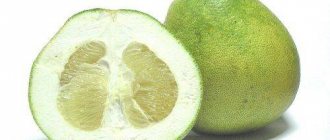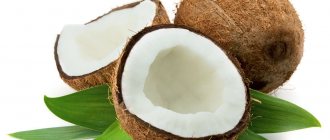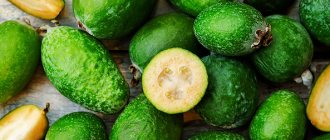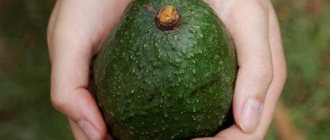In our supermarkets, in addition to the usual oranges and tangerines, there are other citrus fruits. For example, a pomelo fruit similar to a throwing ball. It tastes a little like grapefruit. But, unlike it, pomelo is sweeter, and its bitterness is less pronounced.
How to pronounce the name of the fruit correctly and where to put the emphasis? The emphasis in this word is on the second syllable – “broom”. And this word is not inflected in any way; in any case and in any number it is used in the same form.
If you suddenly hear that a citrus fruit is called “shaddock”, know that this is not some kind of new product, it is a pomelo. So it is sometimes called in honor of the navigator Shaddock. Thanks to him, the fruit was brought to Europe and the world learned about this type of citrus fruit.
Initially, this plant grew on the islands of Polynesia and the Malaysian archipelago. Later it came to Asia Minor, China, Thailand, where it became quite popular.
In China it grows in large quantities. The pomelo fruit is often given as a gift, which symbolizes well-being and prosperity.
Read on and you will learn all about the beneficial properties of this type of citrus fruit, whether it can be given to children, how to choose the right one, and whether there is any harm from the overseas fruit.
Kinds
Shaddock is an evergreen tree with a spherical crown, up to 15 meters high. The leaves are large, the flowers are single or in inflorescence, 3–7 centimeters in diameter, white. The fruits are massive, covered with a thick peel. The pulp is divided into large segments, compacted with a rigid partition, inside of which there are seeds.
Popular varieties of pomelo:
- "Khao horn". The pulp is white, sweet. The peel is yellowish-green. Visually, the fruit resembles a grapefruit.
- "Khao namphung". The fruits have a pear-shaped configuration, the flesh is light yellow and sweet. The peel is greenish-orange, reminiscent of a lemon.
- "Khao paen." This variety was bred in the USA in 1929, and has been cultivated in the south of Bangkok for more than 160 years. The fruit is soft and shaped like a flattened ball.
The thickness of the peel is up to 2 centimeters, green in color. With prolonged storage it becomes wrinkled. The pulp is white, divided into 12 - 15 segments, the film is thin, easily peeled off. The fruit is juicy, sweet with a sour-bitter tint. - "Khao phuang" Brought out in 1913 in the Philippines. The original fruit was taken from Prince Jugelar's garden and grafted onto a tangerine tree. The fruit has an oblong configuration, resembles a pear with a neck, and reaches 12 centimeters in width. The peel is shiny, smooth, greenish-yellow in color, 1.5 centimeters thick. The pulp consists of 12 segments, there are almost no seeds. The ripe fruit is juicy, sweet and sour, and not bitter. The main exporters of this variety are the USA (California), Thailand.
- "Thongdi". The fruit has a spherical shape, the shell is green. The diameter of the fruit is 15 centimeters, the peel is thin, up to 1 centimeter. There are a lot of seeds, the flesh is juicy, sweet, deep pink. The tree is unpretentious and grows in unfavorable conditions for citrus fruits.
Pomelo is eaten raw. The hard film is not suitable for consumption; it is removed from the pulp. Interestingly, the sheddock tree can bear fruit for up to 7 months a year. The size, color and taste of the fruit depend on the plant variety.
How a pomelo blooms, what its fruits look like, what they are like inside
The tree blooms with white star-shaped flowers. In one season, inflorescences are formed several times. Thanks to this, the yield increases; with proper care, you can harvest the fruits four times a year. The largest number of fruits can be collected in early February and until the end of March.
Pomelo fruits are similar to grapefruits, differing only in size.
The weight of one fruit reaches 10 kilograms, and the volume reaches 30 centimeters. If you grow a pomelo outside of its native conditions, then the fruit will weigh a little more than one kilogram, with a diameter of 15 to 20 centimeters.
The fruit is round in shape, in rare cases it becomes pear-shaped. There is a thick peel, which is covered with a white layer inside. The peel may be pink, green or yellow. It all depends on how long the fruits were in the sun. The sunny side has a more saturated color.
The inner part is divided into segments, there is a small amount of seeds, and the flesh is red or yellow. The taste of the berry is bitter. Color and shape vary depending on the variety and ripeness of the product.
What are the benefits and harms?
Pomelo is a dietary and low-calorie product. 100 grams of ripe fruit pulp contains only 38 calories. The exotic fruit, like other citrus fruits, contains a lot of vitamin C (53 milligrams per 100 grams) and has a strengthening, anti-inflammatory, and tonic effect. Shaddock fruits contain limonoids, which stop the development of cancer cells. And bioflavonoids from the peel fight diseases of the digestive organs (intestines, pancreas, stomach). The leaves of the evergreen citrus tree are used to treat ulcers and eliminate swelling.
Interestingly, pomelo fruits contain a lipotic enzyme that breaks down fatty deposits and prevents the accumulation of new ones. Eating one fruit daily can not only improve your health, but also reduce weight.
Advantages of a pomelo:
- improves kidney function;
- inhibits the growth of Escherichia Coli bacteria;
- reduces bleeding gums;
- strengthens teeth;
- increases the body's resistance;
- stimulates hemoglobin production;
- improves iron absorption;
- prevents the formation of osteoporosis;
- lowers blood pressure;
- cleanses the body of waste and toxins;
- improves the well-being of patients suffering from atherosclerosis;
- increases performance;
- normalizes cardiovascular activity;
- resists the formation of blood clots in blood vessels, increases their elasticity;
- restores vitality;
- quenches thirst well;
- reduces the risk of developing diabetes;
- activates metabolic processes;
- saturates brain cells with oxygen;
- prevents constipation.
Pomelo is a healthy vitamin product recommended for consumption by the expectant mother.
Thanks to its rich vitamin composition, it not only saturates the pregnant woman’s body with beneficial nutrients, but also increases the body’s barrier functions.
Indications for use of citrus fruit:
- irritability, apathy, inability to withstand stress, depression;
- slowing down metabolism;
- disorders of the gastrointestinal tract;
- hypertension;
- fragility of bone tissue (and teeth);
- arthritis;
- atherosclerosis.
Contraindications:
- individual intolerance (allergy to citrus fruits);
- increased stomach acidity;
- ulcer of the duodenum, stomach;
- hepatitis, nephritis, colitis.
FAQ
How to eat pomelo?
- Wash the fruit under water.
- Make five cuts from top to bottom, 7 millimeters deep.
- Carefully remove the peel.
- Peel the slices from the thick bitter film.
The fruit is ready to eat.
To start metabolic processes, quench thirst, and lift your mood, it is recommended to eat three to five slices of pulp on an empty stomach daily (up to 500 grams per day). The maximum single serving for pregnant women is two slices. Excessive eating of pomelo increases the acidity of gastric juice, causing heartburn, which often accompanies a woman during pregnancy. If you have problems with stool, eat the pulp along with the films, they activate intestinal motility and have a laxative effect.
Pomelo is introduced into the diet of children no earlier than the third year of life. You need to start with a few drops of freshly squeezed juice, which are first dissolved in boiled water.
Use moderation and caution so as not to provoke allergies in your baby.
Grapefruit or pomelo?
These fruits belong to the citrus genus and are similar in appearance. Pomelo tastes sweet and sour, while grapefruit has a specific bitterness that not everyone likes. Both fruits have low calorie content and a rich vitamin and mineral composition. Therefore, they are often used in programs for weight loss, treatment of the cardiovascular system, and normalization of metabolic processes. Pomelo contains 1.5 times more vitamin C than grapefruit. In addition, it is a natural storehouse of fiber, which removes fluid from the kidneys and improves food digestion.
Grapefruit is a source of niacin, which slows down the aging of the body and regulates carbohydrate and fat metabolism.
As a result, each citrus fruit is useful in its own way, the difference is in the “set” and amount of active substances.
Why is pomelo bitter?
The ripe fruit has a pleasant sweet-sour taste. The bitterness of pomelo comes from the white films between the fibers of the pulp. Clean them. Also, the fruit tastes bitter if it is not ripe.
What are the benefits of pomelo for losing weight?
This is a low-calorie dietary fruit (38 calories per 100 grams), which instantly satisfies hunger and makes you feel full. Shaddock activates metabolism, improves the breakdown of fats, and supplies the body with vitamins, macro- and microelements.
Is pomelo a citrus hybrid?
No. Pompelius is an independent fruit brought to Europe in the 17th century by the commander of the East Indian Fleet, Captain Shaddock. It has nothing to do with the hybrid.
Interestingly, as a result of crossing grapefruit, pomelo and tangerine, a new citrus fruit, sweetie, appeared.
Can people with diabetes eat sheddock?
Yes. The glycemic index of pomelo is 30 units, which means that the citrus fruit is absolutely safe for people with pancreatic dysfunction. In addition, when consumed regularly, pomelo naturally reduces blood sugar levels.
When to eat shaddock?
The fruit can be consumed at any time of the day, but it is better in the first half of the day. It should not be combined with the main meal, since citrus fruits impair the digestion of other foods and can cause gas formation. Pomelo is no exception to the rule. It is recommended to eat the fruit in the intervals between breakfast, lunch and afternoon snack, at least 30 minutes before the start of the meal or 1.5 hours after it. In the event of a sudden attack of hunger, you are allowed to eat several slices of the fruit before bed, at least 2 hours in advance, so that the digestive system has time to “calm down” before bed. The fruit should not be washed down with water.
Beneficial features
The Chinese know exactly how fruits are beneficial. They prepare all kinds of medicines from them, and from all parts of the fruit. These drugs are used in the treatment of a variety of diseases.
The chemical composition of the product confirms that this fruit is worth paying attention to.
Composition of pomelo and calorie content
The product contains vitamins such as C, E, P, K, beta-carotene, vitamins B1, B2, B5 and B9.
They have a rich mineral composition - potassium, calcium, phosphorus, iron, magnesium, manganese, sodium, zinc, sulfur.
It also contains other beneficial substances, such as essential oils, flavonoids, limonoids, and the fruits are rich in fiber.
In 100 gr. The edible part of the fruit contains:
- proteins – 0.76 g;
- fats – 0.04 g;
- carbohydrates – 8.62 g;
- water – 89.1 g;
- fiber – 1 g.
The energy value of citrus is 38 kcal per 100 g of product.
Benefits for the human body
Let's talk in more detail about how the beneficial substances of the fruits of this citrus affect the human body.
- Essential oils and vitamin C, which pomelo is rich in, strengthen the immune system, which helps in the fight against various viruses. Therefore, it is advisable to include fruits in your diet in the autumn-winter period, when there is a danger of colds and flu.
- Fruit juice tones, invigorates and gives additional energy to our body. This is facilitated by both vitamin C, which supports the functioning of the nervous system, and essential oils, which affect a person’s emotional state.
Therefore, pomelo fruit is often classified as an antidepressant product.
- It is useful to consume this type of citrus fruit for the prevention of arthrosis, osteochondrosis, and joint diseases. This is again thanks to the high content of vitamin C, which ensures the synthesis of collagen, which is important for cartilage tissue.
- Vitamin C helps to better absorb the iron contained in the fruit, which makes this fruit a useful product for the prevention of anemia.
- Pomelo contains beta-carotene, which, under the influence of digestive enzymes, is converted into vitamin A. The benefits of this vitamin are enormous - it affects our vision, is responsible for the youth of cells, is useful for the skin and bone formation, and supports the immune system.
Preventing cataracts and improving visual acuity in the dark - a pomelo will also help with this.
- Potassium makes this fruit beneficial for the heart and the entire vascular system, fights vascular atherosclerosis, and normalizes blood pressure.
- The product is rich in fiber, which means that the pulp of the fruit cleanses the human body well and has a positive effect on the digestive system.
- The enormous benefit of the fruit is that it is a powerful diuretic product. In this, it is not inferior even to watermelon, which is rightfully recognized as the best berry for cleansing the kidneys of toxins.
For men
The content of essential oils in the fruit makes it a natural aphrodisiac. Due to this, a man’s sexual attraction to the opposite sex increases.
It has long been believed among the Chinese that if a man is given a broom, it means that he is wished for masculine strength and longevity.
Vitamin C and antioxidants strengthen blood vessels, which improves blood flow in the pelvic organs. This has a beneficial effect on erectile function. Studies of the fruit have shown that the pulp of the fruit improves the process of spermatogenesis.
Antioxidants are able to remove toxins from the body, so this type of citrus is considered the best remedy for relieving a hangover.
For women
- The pulp and peel of the fruit contain flavonoids, limonoids, and essential oils. These beneficial substances prevent pancreatic dysfunction. They also prevent the development of cancer cells in the mammary gland.
- Essential oils contained in the peel of the fruit have a beneficial effect on women's health, eliminating excess estrogen. Apparently, it’s not for nothing that the Chinese use all parts of this plant.
- Pomelo is rich in calcium and phosphorus, and this makes this fruit useful for women during menopause, when there is a threat of osteoporosis. Regular consumption of fruit pulp strengthens bones and promotes the healing of fractures.
- The fruit is interesting for women because it can be used in cosmetology. The juice and pulp nourish well, moisturize the skin, and smooth out wrinkles. You can wipe your face with a pomelo slice instead of washing your face in the morning. You can also make masks by adding other components depending on your skin type.
For pregnant
The fruits of this plant are also beneficial for pregnant women. Moreover, it can be included in the diet throughout the entire period of pregnancy, since folic acid has a beneficial effect on the development of the fetus.
- Phosphorus and calcium help strengthen bones not only in women. They have a positive effect on the development of the child’s skeletal system and muscle tissue.
- The diuretic properties of the fruit will help cope with edema, which often occurs during pregnancy.
- Pomelo is useful for pregnant women in the early stages, as it helps fight toxicosis.
For weight loss
Since this is a low-calorie fruit, nutritionists advise including it in the diet of those who want to lose weight and those who are watching their weight. At the same time, it is sweeter than the same grapefruit, which has only 3 kcal less per 100 g.
- Fiber improves metabolism, which is also important for weight loss.
- The pulp of the fruit contains slow carbohydrates that take longer to digest. A few slices of pomelo are enough to saturate the body and suppress hunger.
- The enzymes found in this type of citrus fruit break down fats, which means that they can be included in the menu for those losing weight.
For the child's body
Knowing about the above-mentioned beneficial properties of pomelo, we can safely say that it can also be present in the children's menu:
- the fruit copes well with vitamin deficiency and will make it easier to endure the cold season;
- Children are often overweight. Pomelo is capable of converting fats into energy, and this will only be for the benefit of the child;
- The fruit helps with fatigue, lethargy, drowsiness;
- The phosphorus contained in the fruits will increase the intellectual abilities of your child.
For diabetes
The beneficial properties of pomelo are also needed by people diagnosed with diabetes. With such a serious disease, a deficiency of one or another element can cause serious consequences.
- In patients with this disease, blood flow is often slowed down, and this contributes to the accumulation of toxic products in the body's cells, and self-poisoning of the cells occurs. An increased dose of vitamin C, which acts as an antidote, helps solve this problem.
- In diabetes, the vessels of the retina of the eyeball are damaged, the body's ability to resist various types of infections is reduced, and wound healing occurs more slowly. Vitamin A helps maintain these functions.
- Potassium is very important in diabetes. It has the ability to convert glucose into glycogen. Potassium reduces the symptoms of diabetes - thirst, numbness of the limbs, frequent urination, skin abscesses. Often people with diabetes have a disorder of carbohydrate metabolism, and this, as a consequence, a disorder of potassium metabolism. Although an excess of potassium is also dangerous to health.
All of the above makes this citrus a truly useful product for patients with diabetes.
But this is a serious disease, so before using anything in your diet, especially in any increased doses, you should definitely consult with your doctor.
Chemical composition
Pomelo, like all fruits of the citrus family, contains many vitamins and minerals, among which ascorbic acid predominates.
Due to the presence of a lipolytic enzyme in the composition, which accelerates the breakdown of proteins, sheddock is classified as a dietary product.
The ripe fruit is soft and emits a wonderful aroma, which contains notes of orange, banana, grapefruit, and lime. Table No. 1 “Nutritional value of pomelo”
| Components | Contents per 100 grams of product |
| Calorie content of dried fruits | 302.80 calories |
| Calorie content of dried fruits | 265.00 calories |
| Calorie content of candied fruits | 221.90 calories |
| Calorie content of freshly squeezed juice | 41.30 calories |
| Calorie content of fresh fruits | 38.10 calories |
| Water | 89.10 grams |
| Carbohydrates | 8.62 grams |
| Alimentary fiber | 1.0 grams |
| Squirrels | 0.76 grams |
| Ash | 0.48 grams |
| Fats | 0.04 grams |
Table No. 2 “Chemical composition of pomelo”
| Name | Nutrient content per 100 grams of product, milligrams |
| Vitamins | |
| Ascorbic acid (C) | 61 |
| Riboflavin (B2) | 0,027 |
| Niacin (B3) | 0,22 |
| Thiamine (B1) | 0,034 |
| Pyridoxine (B6) | 0,036 |
| Macronutrients | |
| Potassium | 216 |
| Phosphorus | 17 |
| Calcium | 4 |
| Magnesium | 6 |
| Sodium | 1 |
| Microelements | |
| Iron | 0,11 |
| Copper | 0,048 |
| Zinc | 0,08 |
| Manganese | 0,017 |
Pomelo is consumed in fresh and processed forms. This is an exotic addition to Asian and European dishes. Sheddock is used to decorate holiday tables, served as a light snack with alcoholic drinks, baked with meat, seafood or caramelized. Citrus pulp is the basis of jelly desserts, fillings for pies, marmalade, candied fruits, sweet and sour sauces, and fruit cocktails.
general description
The Latin name of the plant, Cītrus māxima, is quite justified - pomelo produces the largest fruits of all citrus fruits. The diameter of one can reach up to 30 cm, and it most often weighs 1-3 kg. There are varieties with giant fruits weighing up to 10 kg.
Pomelo fruit wrapped in plastic
The peel is thick (2-4 cm), porous, of medium density. The outside may be green, orange or light yellow (zest), the inside is white and spongy (albedo).
Under the peel, like all citrus fruits, there is juicy pulp in the form of slices. Most often it is pale yellow, there are varieties with greenish, pink, yellow-pink inside. Between the slices there is a white dense film that tastes bitter. It is easily removed when cutting, releasing shiny, juice-rich segments consisting of many juicy “rods” separated by a thin shell. The taste of the pulp is sweet and sour, with slight notes of bitterness, refreshing, not pronounced.
The longer the fruit lies picked, the less juicy it becomes. The fruits of many varieties of pomelo initially contain less juice per unit weight than lemons, oranges, and grapefruits. The pomelo season is the winter months (January-February), when the fruits are harvested, and the fresh harvest is the juiciest.
There is an opinion that pomelo is a citrus hybrid. In fact, pomelo is a separate type of citrus fruit, completely independent and with a long history. Together with the orange, it became the ancestor of the grapefruit. Later, pomelo was crossed with white grapefruit to create sweetie. Today, breeders continue to work with a variety of citrus fruits, including pomelo, which has many advantages.
Application in cosmetology
Masks are made based on pomelo to nourish and moisturize the skin.
Recipe No. 1
Peel one slice of the heavy fruit, remove the white film, and chop the pulp. Add 5 milliliters of lemon juice and honey. Mix the resulting mixture thoroughly and apply to cleansed skin for 10 minutes. Rinse your face with green tea or warm boiled water. The mask has a moisturizing and toning effect.
Recipe No. 2
Peel and thoroughly mash one segment of the fruit, add 5 milliliters of kefir. Soak gauze in the resulting liquid and apply it to your face for 15 minutes. Then rinse off with cool water. This mask will relieve your skin of oily shine.
Recipe No. 3
Mix pomelo juice and boiled water in equal quantities. Wipe your face with the resulting tonic every day during the cold season. After 2 months of regular treatments, you will find that your skin has become fresher and younger.
Where and how does pomelo grow? When does it ripen and harvest?
The homeland of the fruit is considered to be the southern part of China, and some equatorial islands in the Pacific Ocean. Pomelo grows quite actively in the Cook Islands. In addition, pomelo is now grown in Indonesia, Taiwan, Japan, Vietnam, Israel, and California.
The tree blooms and bears fruit 2-4 times a year. Fruits ripen within 5-7 months.
Citrus fruits grow on trees whose height can reach 8-10 meters. Tree branches with large leaves with a glossy surface. Also on certain species there are large quantities of internal spines. During flowering, large white flowers appear on the tree. When fruits appear, they can be located either singly or next to each other in 6-8 pieces.
The fruits usually ripen in February.
How to choose and store fruit?
Pomelo fruits come in round, oblong and flattened shapes, and the color varies from bright golden to greenish. Remember, configuration and color do not affect the taste of the fruit, they depend solely on the variety of the citrus plant.
Ripe pomelo:
- heavy in weight;
- dense, with elastic, shiny skin;
- no stains, damage;
- emits a strong citrus aroma (the richer it is, the riper the fruit).
The fruit ripening season is in February. The undeniable advantage of pomelo over other citrus fruits is the possibility of long-term storage at room temperature (up to 30 days) without loss of freshness. It is better to eat the peeled fruit immediately or place it in the refrigerator. After 3 days it will lose its aroma and taste, so it must be eaten within this period. In a dry, cool place, sheddock stays fresh for up to 120 days.
Are there any contraindications for use?
Any product has its pros and cons, pomelo is no exception. For some diseases, you need to eat it with caution, or avoid it altogether.
Due to the large amount of acids, it is worth limiting consumption to people who have high acidity, stomach ulcers or diseases of the gastrointestinal tract.
Contraindicated for nephritis and hepatitis.
All citrus fruits are strong allergens, so you should exercise caution during breastfeeding and pregnancy.
Pomelo for weight loss
Due to its low calorie content, the tropical fruit is used for mono-diets or fasting days.
Pomelo activates metabolism, suppresses appetite, improves the breakdown of proteins and fats, and removes waste and toxins from the body. The duration of the citrus nutrition program should not exceed 3 days. Otherwise, you can get inflammation of the digestive organs (pancreatitis, ulcers, chronic gastritis). In addition, the organic acids contained in pomelo negatively affect tooth enamel. Therefore, rinse your mouth with water every time after eating fruit.
Menu for one day:
- breakfast – sheddock – 0.5 pieces, cheese – 50 grams, coffee without sugar – 40 milliliters;
- lunch – boiled fish – 150 grams, a portion of vegetables (stewed) – 200 grams, green tea – 250 milliliters;
- afternoon snack – boiled egg – 1 piece, pomelo – 0.5 pieces;
- dinner - apple salad and 0.5 pieces of pomelo, boiled cauliflower - 100 grams, boiled egg - 1 piece.
According to this scheme, it is recommended to “unload” the body once a month. In addition to weight correction, a citrus diet saturates the body with vitamins and minerals, improves complexion, cleanses of harmful substances, and improves well-being.
Growing at home
Pomelo reproduces by seeds and air layering. At home, the first option is used.
Pomelo from a seed
Seeds should be extracted from mature, high-quality fruits, or rather, from their lobules. When choosing seeds, be sure to ensure that they are not damaged or deformed. They need to be washed and dried, and then soaked in lukewarm water for 10–12 hours. Next, it is recommended to germinate the seeds, for which they should be wrapped in a damp cloth (cotton wool, sponge, sphagnum moss) and placed in a warm place for several days, periodically wetting the “cushion”. You can start planting them in the ground after the sprouts appear.
It is necessary to prepare a pot or container (necessarily - with drainage holes at the bottom!). The bottom layer (about 4–5 cm) may consist of expanded clay, crushed stone, crushed brick or pieces of foam. The main soil should contain humus, turf soil and sand. It is recommended to purchase the mixture at a flower shop.
Growing at home Photo: © James Steakley
The sprouted seeds should be placed in holes about 3 cm deep and sprinkled with earth. Stronger sprouts are transplanted using the transshipment method to avoid damage to the delicate roots. When the pomelo has entwined the entire soil layer with its root system, the citrus fruit will need to be moved to a larger container, following the process described above.
Advice Do not replant the plant at the moment of flowering and fruiting!
Regime and care
For good development of citrus fruit, warm conditions (up to +30–35 degrees) and relatively humid air in the range of 65–85% are suitable. During the cold season, the temperature should not fall below +12–15 degrees. When choosing a location, it is necessary to take into account that pomelo loves sunlight, but not direct rays, and does not tolerate proximity to heating devices.
The plant should be watered individually, avoiding drying out or waterlogging the soil. In this case, the water must be settled, melt or rain. Excessive zeal, as well as insufficient care of the pomelo, can cause harm and destroy the plant.
Flowers and buds Photo: © Daderot
Advice In summer, soil moisture should be monitored daily.
Citrus requires:
- fertilizing - mineral and organic fertilizers are sold in stores and markets;
- crown formation - you need to pinch the top when the side shoots are formed;
- protection against pests - it is recommended to use biological preparations rather than pesticides;
- spraying leaves - from a spray bottle 1-2 times a day in summer, once a week in winter and in the shower once a month;
- additional lighting in winter - using a fluorescent lamp or LEDs with a warm color range.
Pomelo flowers can be expected in the third year of citrus life, but fruits are not always set. This can happen in a few years if the optimal development regime of the plant is observed, with proper care and pollination.
Conclusion
Pomelo is an antidepressant fruit; it improves emotional well-being, increases performance, and fills you with vivacity, energy and strength. Strengthens the immune system, increases bone strength, improves metabolism, the functioning of the digestive, nervous, and cardiovascular systems. In addition, the fruits contain folic acid, which is necessary for the normal course of pregnancy. Essential oils resist pathogenic viruses, and limonoids prevent the growth of malignant tumors, the development of neuralgic diseases, and cataracts.
More fresh and relevant information about health on our Telegram channel. Subscribe: https://t.me/foodandhealthru
We will be grateful if you use the buttons:
Pomelo - what is it, a hybrid of what, what is it crossed with?
Some people, out of ignorance, believe that pomelo is a hybrid species, since it appeared by crossing grapefruit or orange. But that's not true. Pompelmus is not a hybrid, but an independent fruit.
It looks similar to grapefruit, there is the same white layer inside the pulp, this is explained by the fact that grapefruit was obtained by crossing an orange and a pomelo.
This fruit has healing and cosmetic properties, so it is widely used in medicine, cooking and cosmetology.











